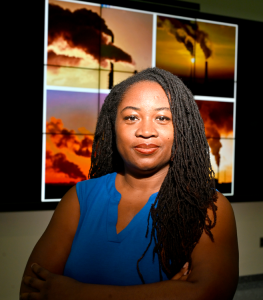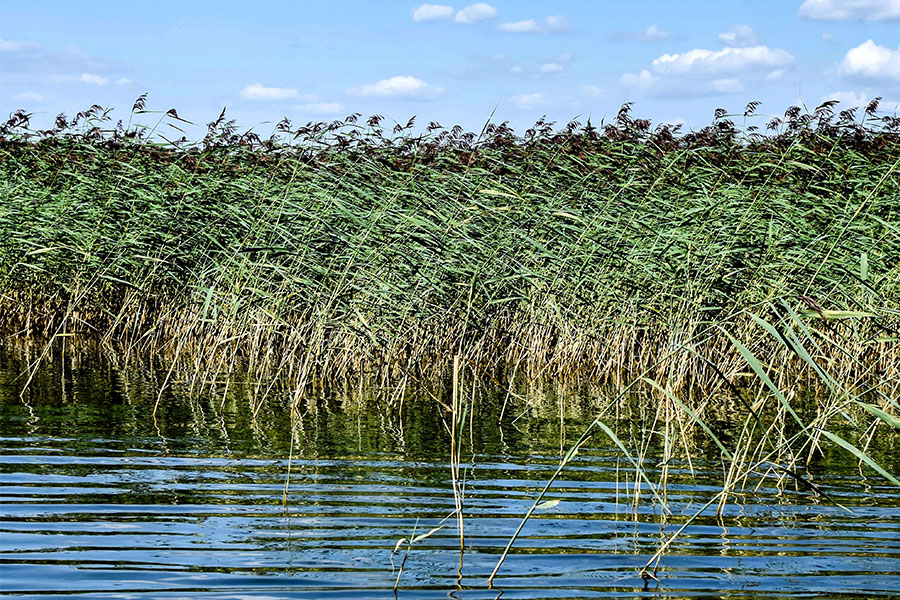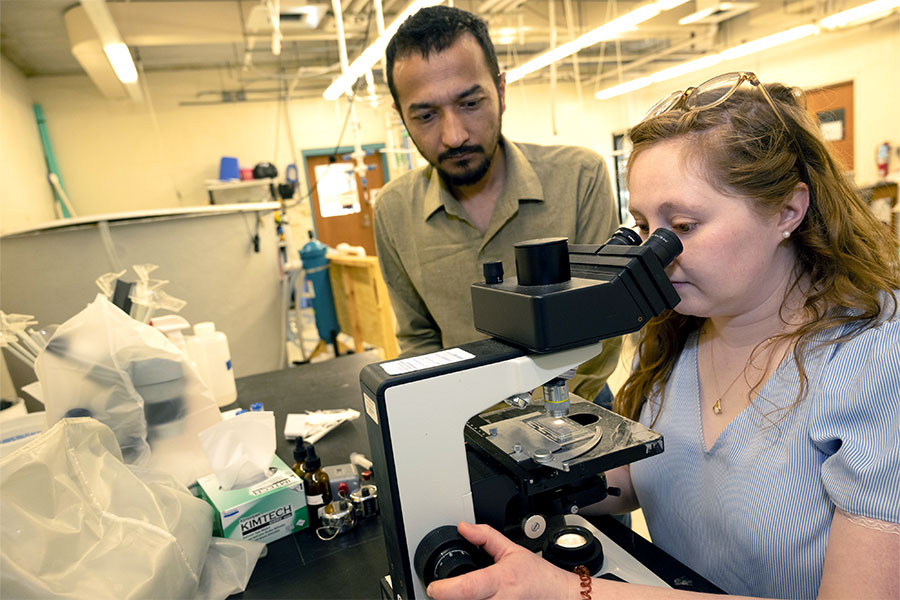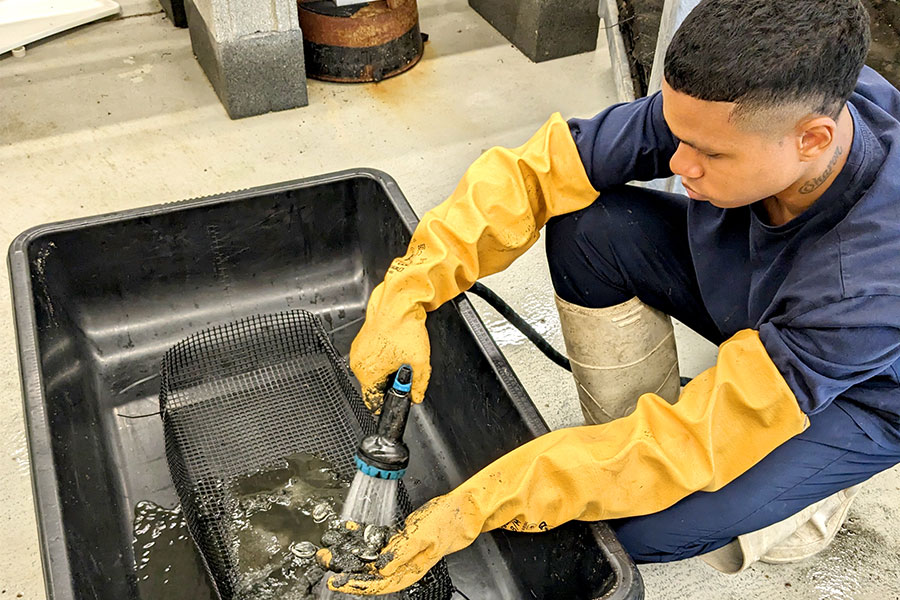By: Eric Addison
Morgan Researchers Seek Equitable Actions to Lessen the Impacts of Climate Change
When 12 of the nation’s leading scholars and scientific researchers gathered at Morgan State University in September 2021, one of the main tasks of the group, dubbed the “Blue Ribbon Panel on STEM Research Expansion,” was to suggest core research areas Morgan should explore in the near future. The panel evaluated Morgan’s prospective science, technology, engineering and mathematics (STEM) research “Peaks of Excellence” to determine how well the University was positioned in each area to make important contributions and become a national leader.
One of the most promising peak areas of future Morgan excellence the panel identified was climate change research, and last February, the University announced its most extensive foray into the space. The mission of Morgan’s new Center for Urban and Coastal Climate Science Research is to collaborate with the global scientific community and policymakers to mitigate the most adverse effects of climate change on urban and coastal communities, reports Willie E. May, Ph.D., vice president of Research and Economic Development and professor of chemistry at Morgan.
Global warming caused by burning of oil, coal and gas (fossil fuels), has long been confirmed by the world’s scientific community as a potentially catastrophic problem. Morgan’s newest research center, funded by $2–3 million annually from the State of Maryland, will study climate impacts caused by that warming, such as extreme heat; extreme rain and wind events; drought; and rising sea levels. The research will take place at three “nodes,” Dr. May reports: one at Morgan’s Patuxent Environmental and Aquatic Research Laboratory (PEARL), another in the University’s School of Computer, Mathematical and Natural Sciences, and the third at a location to be determined in downtown Baltimore.
Rising seas give Maryland a special interest in supporting the center’s research, May says, because, “Maryland has more coast per unit area than any other state in the country. We have a lot of water.”
And Morgan has access to that water, points out PEARL Director Scott Knoche, Ph.D.
“The Chesapeake Bay serves as the coastal conduit between Morgan’s urban Baltimore City campus and the Morgan PEARL laboratory located 80 miles to the south in rural southern Maryland,” Dr. Knoche says. “The facilities and resources at these very different coastal locations will enable Morgan to engage in interdisciplinary climate research using integrated approaches available to few universities.”
Morgan is well positioned to help make Maryland a model of climate change resilience and adaptation for other coastal states, says Dr. May. And he adds that the Center “also gives us the ability to contribute to the state’s economic growth.”
Morgan is well positioned to help make Maryland a model of climate change resilience and adaptation for other coastal states
– Willie E. May, Ph.D.
Vice President of Research and Economic Development
and Professor of Chemistry
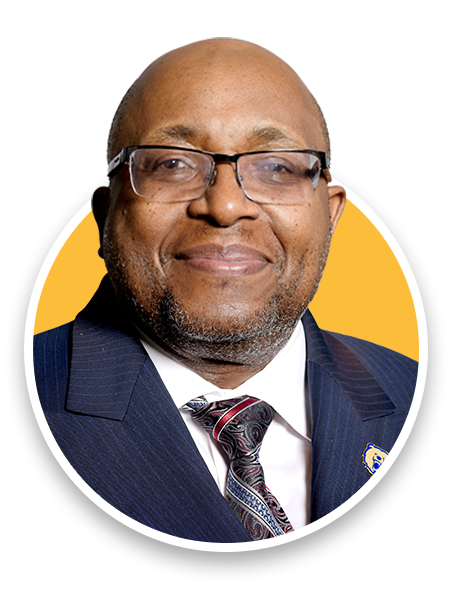
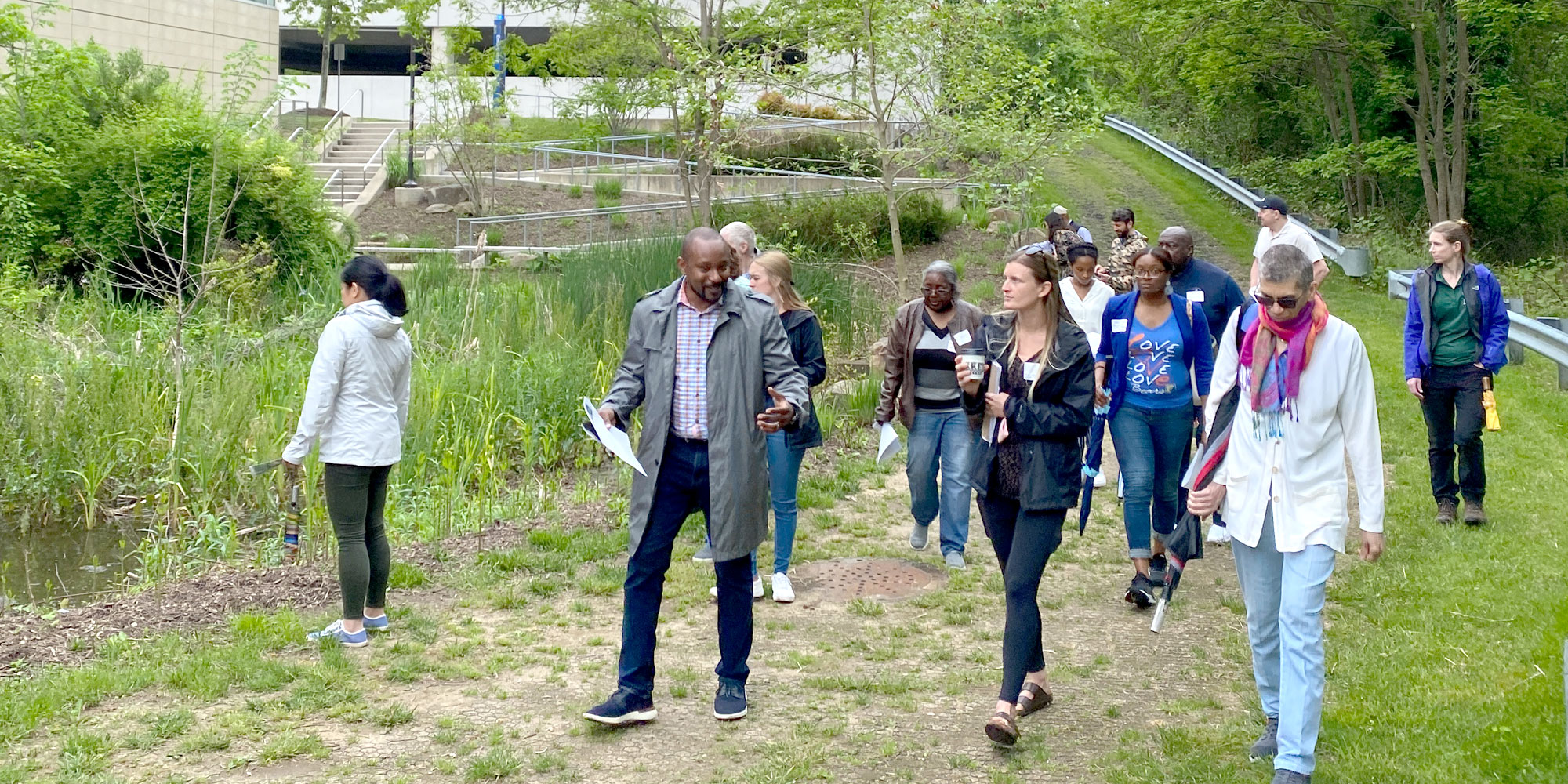
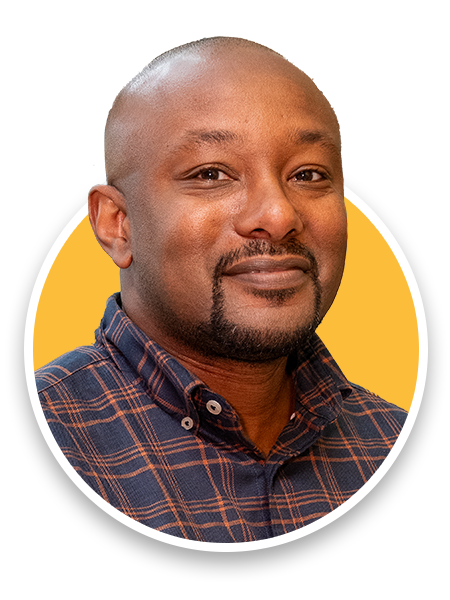
Climate (change) is a huge issue, because it affects everybody, particularly the most vulnerable members of our society.
– Dr. James Hunter
Associate Professor of Civil and Environmental Engineering
A Huge Issue
The Center for Urban and Coastal Climate Science Research is one of the many integrated initiatives recently launched at Morgan to address the enormous challenge of climate change.
James Hunter grew up in Somerset, New Jersey, but he has deep roots in Baltimore City, where his mother was reared and where his father and two of his uncles graduated from college at Morgan State. Before he received his doctorate in Environmental and Civil Engineering from Purdue University in 2006, and before he joined the faculty of Morgan State University in 2009, Hunter was a student at Morgan also, earning his Bachelor of Science in Civil Engineering in 2000.
Environmental problems such as excessive water runoff in urban areas have long been a focus of Dr. Hunter’s research, but when asked about the issues caused by global warming, he immediately turns the discussion to home.
“By 2070, Baltimore will face a significant climate change, marked by a notable increase in days above 95 degrees Fahrenheit, sea level rise and more frequent, intense rainfall. This will lead to higher cooling costs, health risks, property damage and challenges to the water quality of the Chesapeake Bay,” Hunter says, citing a climate outlook report from a program he serves as lead investigator from Morgan: the Mid-Atlantic Regional Integrated Sciences and Assessments (MARISA), sponsored by the National Oceanic and Atmospheric Administration (NOAA).
“Climate (change) is a huge issue, because it affects everybody, particularly the most vulnerable members of our society,” Hunter adds.
Hunter is an associate professor in Morgan’s Department of Civil and Environmental Engineering. (The word “Environmental” was added to the department’s name last year.) He is also Morgan’s lead for the University’s work with the Baltimore Social-Environmental Collaborative (BSEC), a U.S. Department of Energy (DOE)-funded “integrated field laboratory” to study climate adaptations and climate impacts in urban environments. As scientific evidence of the urgency to address climate change accumulates, BSEC, along with Morgan’s new climate research center, have become part of the fast-growing, multidisciplinary effort at Morgan to meet the challenge by assisting Baltimore in adapting to and becoming more resilient to the impacts of global warming.
Given the fact that we are seeing warming now, and there’s no escape, how will that change affect urban climate? How do we help people to manage the extreme heat or flooding or pollution?
– Dr. Xiaowen Li
Director, Climate Science Division
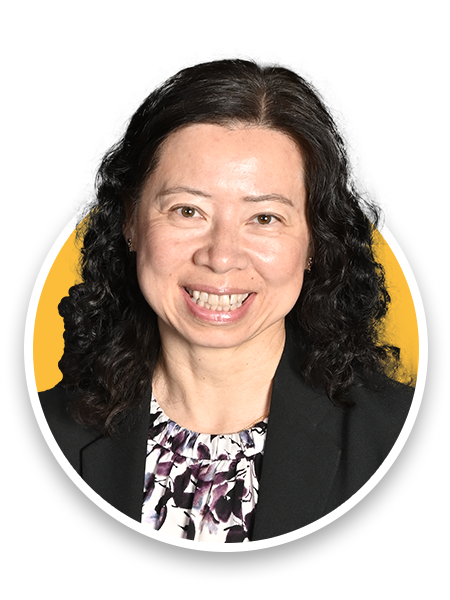
Steps Forward
In July 2022, the University’s School of Computer, Mathematical and Natural Sciences established a Climate Science Division, headed by Xiaowen Li, Ph.D., a researcher for Morgan with NASA’s GESTAR program since 2015. Richard Damoah, Ph.D., assistant professor of Physics at MSU, is her teammate in the division. In early fall of last year, Dr. Li made two major climate research-related announcements: Morgan’s receipt of $250,000 from the DOE for a pilot program to establish a Climate Resilience Center at MSU, and the University’s participation in the Coast-Urban Rural Atmospheric Gradient Experiment (CoURAGE), a field campaign that will support BSEC. Both are Department of Energy-supported projects that she will lead for Morgan as principal investigator.
In April 2023, the University announced its participation in two multi-university collaborations to boost climate resilience in Baltimore and elsewhere: the Environmental Impact Data Collaborative (EIDC), with MSU Computer Science Professor and Chair Shuangbao (“Paul”) Wang, Ph.D., as the Morgan lead, and BSEC, which is led at Morgan by Dr. Hunter, with coinvestigators and collaborators from Morgan’s Biology, Civil and Environmental Engineering, Physics, and Transportation and Urban Infrastructure Studies Departments; the Climate Science Division; and the School of Architecture and Planning. Several months later came the announcement of a $3-million grant to Morgan from the National Science Foundation to train students to research climate change solutions enabled by artificial intelligence and machine learning. That program, dubbed ACCESS, is headed by Samendra (“Sam”) Sherchan, Ph.D., associate professor of Biology at Morgan, who is also director of Morgan’s Center for Climate Change and Health, which was launched last year.
Morgan is realigning its academic offerings to meet the climate challenge, as well. Three of the University’s recently established degree programs have climate resilience solutions in their sights: a Bachelor of Science in Sustainable Environmental Engineering, a Ph.D./M.S. in Sustainable and Resilient Infrastructure Engineering and, beginning this fall, a Bachelor of Science in Coastal Science and Policy.
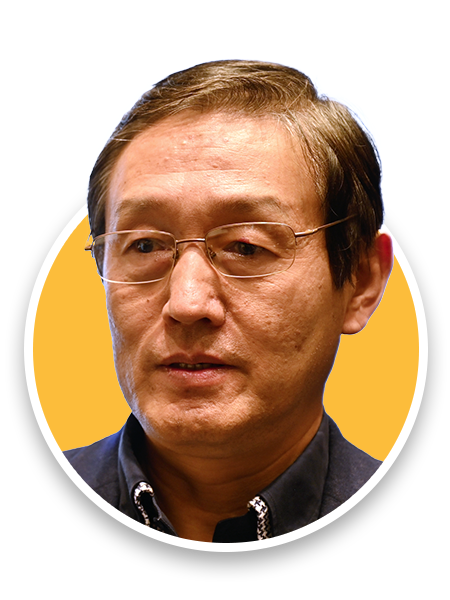
I think the idea is we need to love and treasure the Earth we live on. But also, as a researcher at an HBCU, I want to fight the injustice.
– Dr. Paul Wang
Computer Science Department Chair
Applying the Science
Dr. Li, who earned her bachelor’s degree in Atmospheric Physics and master’s degree in Meteorology in her home country of China, and her doctorate in Geophysical Sciences from the University of Chicago, has spent much of her professional career researching cloud microphysics and cloud dynamics, examining clouds with radar aimed from the ground and from space to help develop models that show how clouds interact with human-induced global warming. While that research aims to determine why the climate is changing and how much it will change over the coming decades and centuries, Li says, the pilot Climate Resilience Center she leads — the Center for Climate Adaptation and Resilience in Baltimore (CCARB) — “is the application part of the science. Given the fact that we are seeing warming now, and there’s no escape, how will that change affect urban climate?” she says. “How do we help people to manage the extreme heat or flooding or pollution?”
Li is working to develop the Center as a host for the unprecedented volume and quality of climate data about Baltimore that is being produced by field campaigns such as BSEC and CoURAGE. Land in Clifton Park that Morgan recently acquired is the main site for the Department of Energy instruments and infrastructure to be used in the CoURAGE study. The long-term goal of the Climate Resilience Center is to become a hub for Baltimore’s climate data, interpreting the information for Baltimore City residents and officials, serving as a two-way communications bridge between climate scientists and city stakeholders, and training a more diverse workforce of climate researchers.
Faculty from nine Morgan units; Coppin State, Johns Hopkins and Penn State Universities; Baltimore City Community College; and Pacific Northwest National Laboratory are working within CCARB.
“Climate sciences really touch every single school and every aspect of everybody’s life,” says Li. “It’s not just about science. It’s (also) about policies and adaptations, and everybody needs to be involved.”
We are trying to increase the diversity of…minority students in STEAM fields (and) also address big challenges right now in terms of climate change, artificial intelligence, big data and related areas.
– Dr. Samendra (“Sam”) Sherchan
Associate Professor of Biology
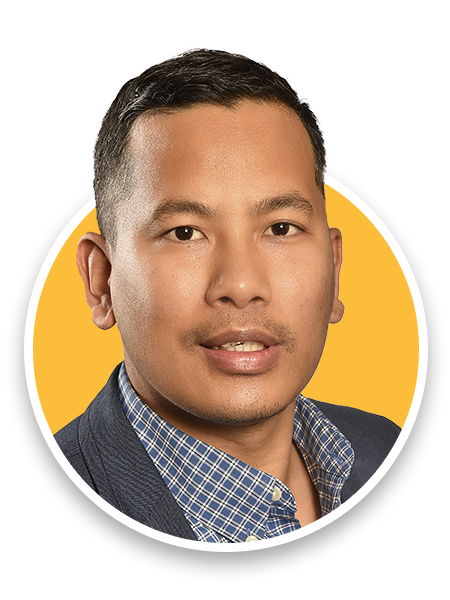
Addressing Climate and Health
The climate research traineeship program headed by Dr. Sherchan has a lengthy name: the National Science Foundation Research Traineeship program in Artificial Intelligence for Climate Change and Environmental SuStainability (ACCESS). The program takes an inclusive approach similar to CCARB’s, involving faculty and students from Morgan’s Biology, Computer Science, Civil and Environmental Engineering, and Electrical and Computer Engineering Departments, and the director of MSU’s Center for Equitable Artificial Intelligence and Machine Learning Systems.
“Climate change is the biggest threat to humankind in the 21st century,” Sherchan states. “We have direct and indirect impacts of climate change, and there are areas where we can utilize artificial intelligence and machine learning to address them.”
One question ACCESS researchers are seeking to answer is how artificial intelligence (AI) can be used to predict contaminants or disease-causing agents in recycled water, as potable water becomes less available in areas stricken by drought caused by climate change. Another is how AI can predict and monitor emerging diseases in communities, as climate change impacts the transmission of infectious diseases. Sherchan is also researching critical questions like these as one of the seven academicians and medical practitioners nationwide selected as National Institutes of Health (NIH) Climate and Health Scholars
Morgan expects that about 75 students will benefit from the research and research presentation opportunities, faculty mentoring and internships gained from the ACCESS program over the five-year grant period, says Sherchan. Twenty-five of the students will be funded with one-year stipends.
“We are trying to increase the diversity of minority students in STEAM fields (and) also address big challenges right now in terms of climate change, artificial intelligence, big data and related areas,” says Sherchan.
Transforming Data Into Solutions
Approximately 30 Morgan students gained research experience through the University’s work with Georgetown and Howard Universities and the Black-owned climate technology company BlocPower, in the Environmental Impact Data Collaborative (EIDC), a project funded by the Bezos Earth Fund, reports MSU Computer Science Chair Paul Wang. Morgan received $1 million from EIDC over the two-year period beginning July 2022, to automate the intake and cleaning of a wide range of climate data using machine learning techniques. The mission of the Collaborative, stated on its website, is “(to help) community groups, policymakers and researchers transform data into solutions that promote environmental justice and fight climate change.”
“What we want to find is how climate change is affecting people, groups or communities that have been adversely impacted by historically biased policies, and present scientific evidence to the policymakers,” said Wang, who is also lead author of a recent report linking historical socioeconomic injustice with poor air quality in Baltimore City neighborhoods.
Morgan’s work with EIDC gained the attention of the Kennedy School of Government at Harvard University. Wang was invited to Harvard to represent Morgan at a forum about environmental justice and its relationship to public health, in June 2023, joining the 30 forum participants, who included city leaders and some of the nation’s top researchers in the subject areas covered at the event. High on the list of topics were ways to address health problems caused by disproportionate climate impacts on low-income communities.
About 20 Morgan Computer Science undergraduates participated in EIDC as part of their senior capstone projects, in addition to six MSU faculty and two graduate students, including one Fulbright scholar, Wang says. Dozens more students benefited from having access to the senior project presentations.
Wang says he has long been concerned about the environmental impact of the burning of fossil fuels but that he has dual goals in addressing climate change in Baltimore City.
“I think the idea is we need to love and treasure the Earth we live on,” he says. “But also, as a researcher at an HBCU, I want to fight the injustice.”
Toward Equitable Adaptation
Achieving socially equitable solutions to climate change impacts is also a stated goal of the Baltimore Social-Environmental Collaborative (BSEC), an 11-member partnership that includes Morgan. The work of Morgan’s BSEC team has a broad reach, as it must keep pace with the multiple challenges created by the fast-growing problem of climate change, says Morgan’s BSEC lead, James Hunter. As an author of the Fifth National Climate Assessment, released last November, he is well aware of the need for swift, comprehensive action.
“In a lot of respects, we may be behind,” he admits, “but we can always still plan for the near future and the far ahead future. And that’s what efforts like BSEC (are) trying to do…. With this particular effort, we are looking at monitoring what’s happening throughout the city, setting up essentially a web of sensors (to measure) climatic data, weather data, air quality, water flow, our soils and vegetation, and then running those data in our models to see how our city is reacting to these different climate impacts.
“But more importantly,” Hunter adds, “we’re going to be able to look at what we call equitable pathways to adapting to climate change.”
Celeste Chavis, Ph.D., is working to help develop the transportation plans for those pathways. In conversations with Dr. Chavis, Morgan associate professor of Transportation and Urban Infrastructure Studies, she noted plans to extend her past research on deployment of electric vehicles to contribute to the BSEC effort.
“We’re interested in looking at how you can shift people to more sustainable modes of transportation,” Chavis says. “One way of moving people to transit is to price cars so it’s too expensive to drive, which is not really equitable, because higher-income earners will still drive, and lower-income earners will be pushed to transit. So we’re interested in exploring ways that we can still create those shifts in a more incentivized way, as opposed to a punitive way.”
Her team is also looking at exploring future trends in transportation, she reports, “so if travel patterns change, how will that affect emissions related to transportation?”
Chavis thinks BSEC’s community engagement is a unique element of the program that will help move the effort toward its goal.
Earning Community Trust
Two faculty of Morgan’s School of Architecture and Planning, Tonya Sanders Thach, Ph.D., associate professor of City and Regional Planning, and Samia Kirchner, Ph.D., associate professor of Undergraduate Design, are leading the University’s community engagement for BSEC. The gathering they assembled in a first-floor classroom of Morgan’s Center for the Built Environment and Infrastructure Studies (CBEIS) building last fall seemed a model of diversity, cooperation and inclusion. The occasion was a focus group on the topic of extreme heat — the second in a series of engagement events to be held during the five-year grant period. The event brought in a wealth of thoughts, ideas and experiences from the 35 guests, who included community leaders and activists from neighborhoods across Baltimore. Youth at the event toured the LEED Silver-certified CBEIS facility and took part in a separate environmental learning activity, while the adults answered questions in the focus group session.
A long period of strategic planning preceded the well-run meeting, Dr. Sanders Thach reports, planning that began with the researchers’ selection of the community organizations to partner with in BSEC.
“You cannot build deep relationships with communities in the time span it takes to write a grant. You (must) have established trust with a community,” Sanders Thach says. “(So) one of the things we did was send a survey to all of the BSEC researchers to see who had worked in what communities.”
Later, the engagement team developed a steering committee for the Collaborative, composed of community residents, government officials and business and nonprofit organization leaders. The community members on the committee are responsible for bringing more community residents to the project, as needed.
The steering committee meets quarterly “to learn about all the scientific discoveries that the scientists are making and (to) guide the BSEC research,” Dr. Kirchner reports. “…Our strategy has been just like the strategy for any community engagement has been to me, which is to make the ship as you sail it, because every community is different.
“So we started BSEC with a kickstart meeting in January of 2023,” she adds. “Over a hundred people showed up, which included residents and city and organizational stakeholders. And we just started with simply listening.”
Sanders Thach, who arrived at Morgan with degrees in Urban Planning and Policy, Community Psychology and Social Change, and Psychology, and Kirchner, an MIT and Georgia Tech graduate with degrees in architecture and conservation, both came to BSEC with a longtime concern about climate change and a long track record of research to solve environmental and environmental justice problems. Sanders Thach recalls the devastation of New Orleans by Hurricane Katrina in 2005 and witnessing the socially inequitable recovery after the disaster. Kirchner remembers her shock at seeing environmentally unsustainable building design and excessive consumer product waste when she arrived in the U.S. from her native Pakistan, in 1988. And both agree on the best path forward to equitable climate solutions now.
“I’ve learned that communities are very well in tune to what is happening to them, and we don’t give them enough credit for it,” Sanders Thach says. “You don’t need a Ph.D. in climate science to know how (climate change is) affecting you.”
“The humans that have been at the receiving end of environmental injustice are experts of their lived experiences,” Kirchner says. “(They) have a lot to teach the scientists.”
I’ve learned that communities
are very well in tune to what is happening to them, and we don’t give them enough credit for it. You don’t need a Ph.D. in climate science to know how (climate change is) affecting you.
– Dr. Tonya Sanders Thach
Associate Professor of City and Regional Planning
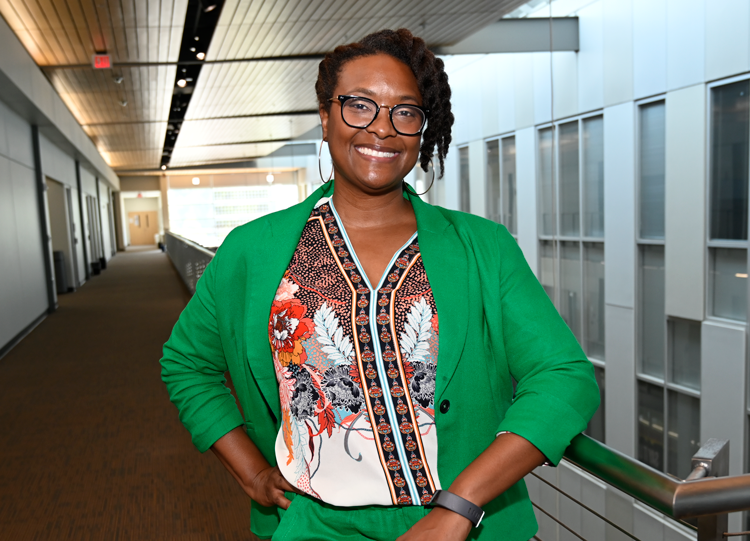
Prepping Morgan Students for Careers in Climate Resilience
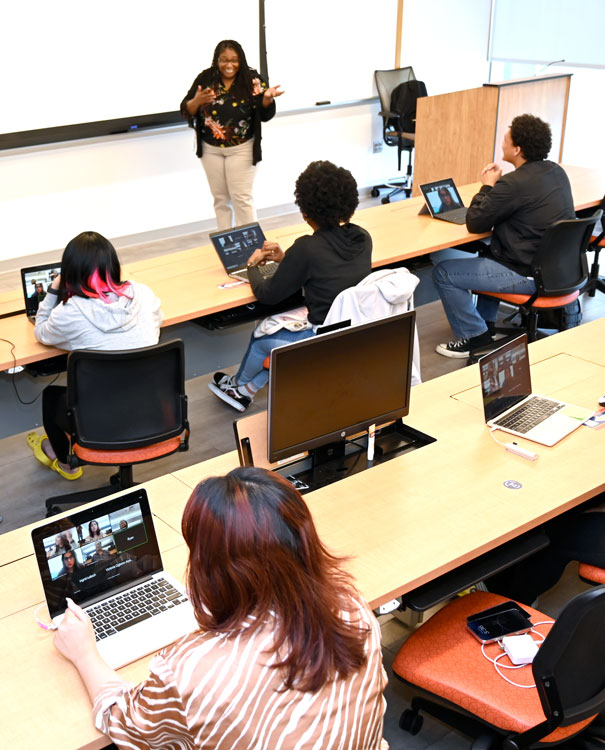
B.S. in Coastal Science and Policy
This unique degree program, beginning in the Fall 2024 semester, will equip students to protect, manage and study coastal resources through the interdisciplinary application of science and policy. The program’s new courses and research opportunities will be focused on natural and social science studies of coastal ecosystems.
B.S. in Sustainable Urban Environmental Engineering
Approved in 2022, this program aims to increase the number of employees from groups now underrepresented in the expanding career fields of environmental sustainability.
Ph.D./M.S. in Sustainable and Resilient Infrastructure Engineering
Morgan graduates are well-represented in the workforce that manages the infrastructure of Baltimore City and the region. As these bridge, roadway, water and other systems age and are increasingly challenged by climate change and other emerging environmental issues, this program, launched in Fall 2023, will prepare students with knowledge about the more complex systems to come.

Climate Research at Morgan’s PEARL
Located on a Chesapeake Bay tributary in St. Leonard, Calvert County, Maryland, Morgan’s Patuxent Environmental and Aquatic Research Laboratory (PEARL) does research to increase the understanding of coastal and environmental systems so they can be properly managed and protected. That mission places global warming clearly in the laboratory’s sights.
“(We have) several projects that are ongoing at the PEARL that have relevance to how we’re going to adapt to and mitigate climate change,” says the lab’s director, Scott Knoche, Ph.D.
One of those projects stems from the PEARL’s work to help diversify Maryland’s growing aquaculture industry.
“A challenge with aquaculture in Maryland is that it’s a single-product industry: it’s oysters, and that’s it. So the PEARL…is doing research on softshell clams,” which are predominantly farmed in Maine and Massachusetts, he says. “We’re at the southern end of their range, and that’s only going to become more problematic with climate change and warming waters.
“So what we’re doing at the PEARL is tests — we call them ‘heat shocks’ — to see which softshell clam specimens will survive in these warmer waters,” Knoche explains.
Another PEARL study looks at the wind turbines being used to produce electricity.
“To reduce our greenhouse gas emissions, (the U.S. is) putting wind turbines into places like mountaintops and in the ocean. That has potentially negative effects on different stakeholders, including commercial fishers who are working in those waters,” Knoche explains. “So the PEARL is providing some background information and will ultimately be surveying commercial fishers to get their take on how these new, large structures in the water could impede their commercial fishing efforts.”
Yet another PEARL research project, led by Amanda Knobloch, Ph.D., environmental education coordinator for the lab, is seeking to understand how the coastal carbon cycle is changing because of climate change and other human impacts. The project — funded by the National Science Foundation — is titled, “Comparing Carbon Fluxes of Tidal Marshes and Oyster Aquaculture Farms in the Chesapeake Bay.”
Tidal marshes are important to ecosystems in numerous ways, Dr. Knobloch explains: filtering sediments, soil and nutrients out of water, acting as nurseries for fish and shellfish, serving as habitats for migratory birds and reducing storm surge flooding, to name a few. The marshes can also act as “sinks” that hold (“sequester”) carbon for long periods of time, she says. That sequestering can affect climate change, because carbon is an element of carbon dioxide, a pervasive greenhouse gas. Dr. Knobloch’s project is examining the movement of carbon between tidal marshes and two different environments — the Patuxent River and oyster aquaculture farms — to determine similarities and differences.
“A big portion of this project is working with students and training students in this field,” Dr. Knobloch says, “to diversify geosciences but also biogeochemistry or marine chemistry as a whole. It’s a small field, and it’s not very diverse. And so I want to train more students in this field that I find so fascinating.”

